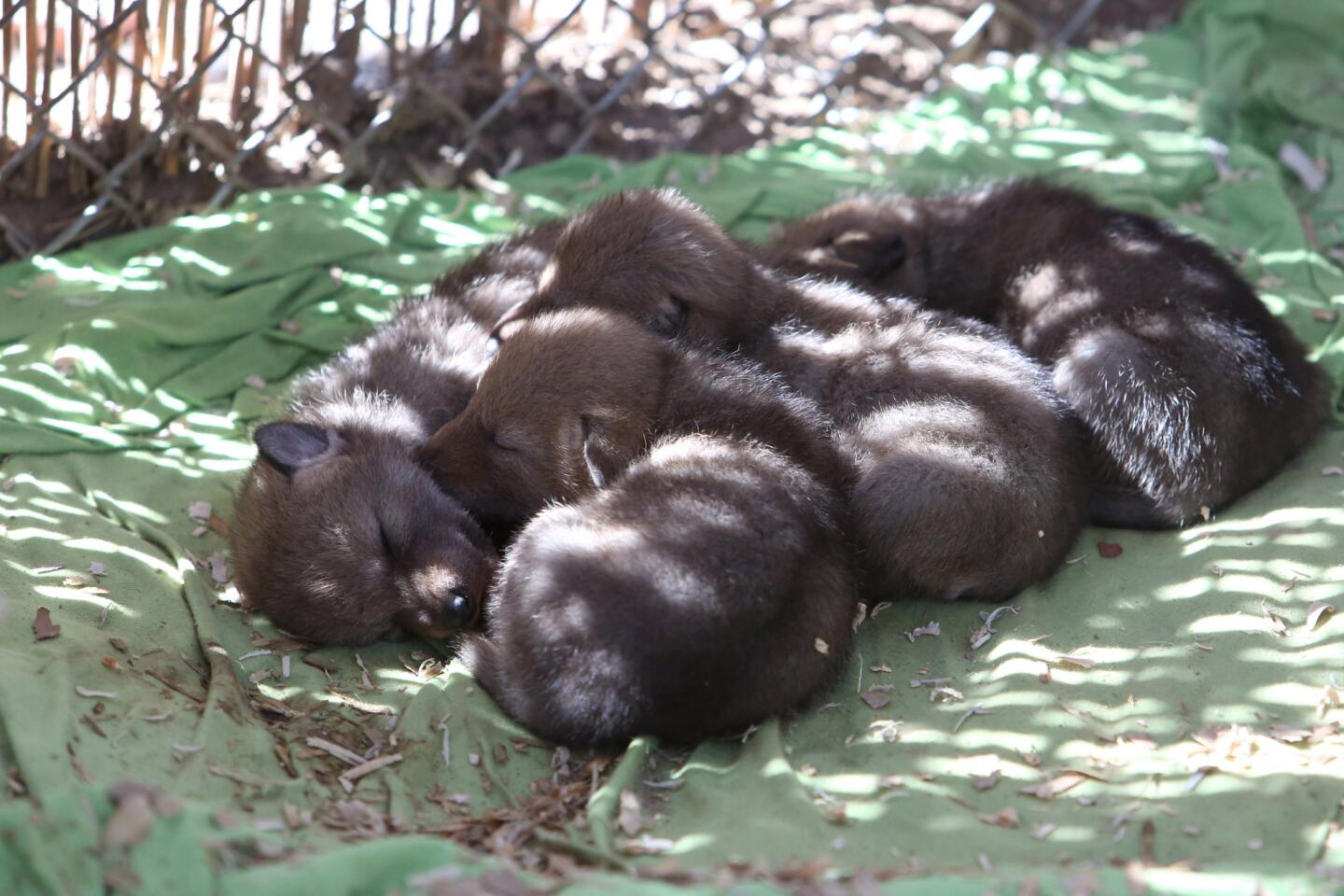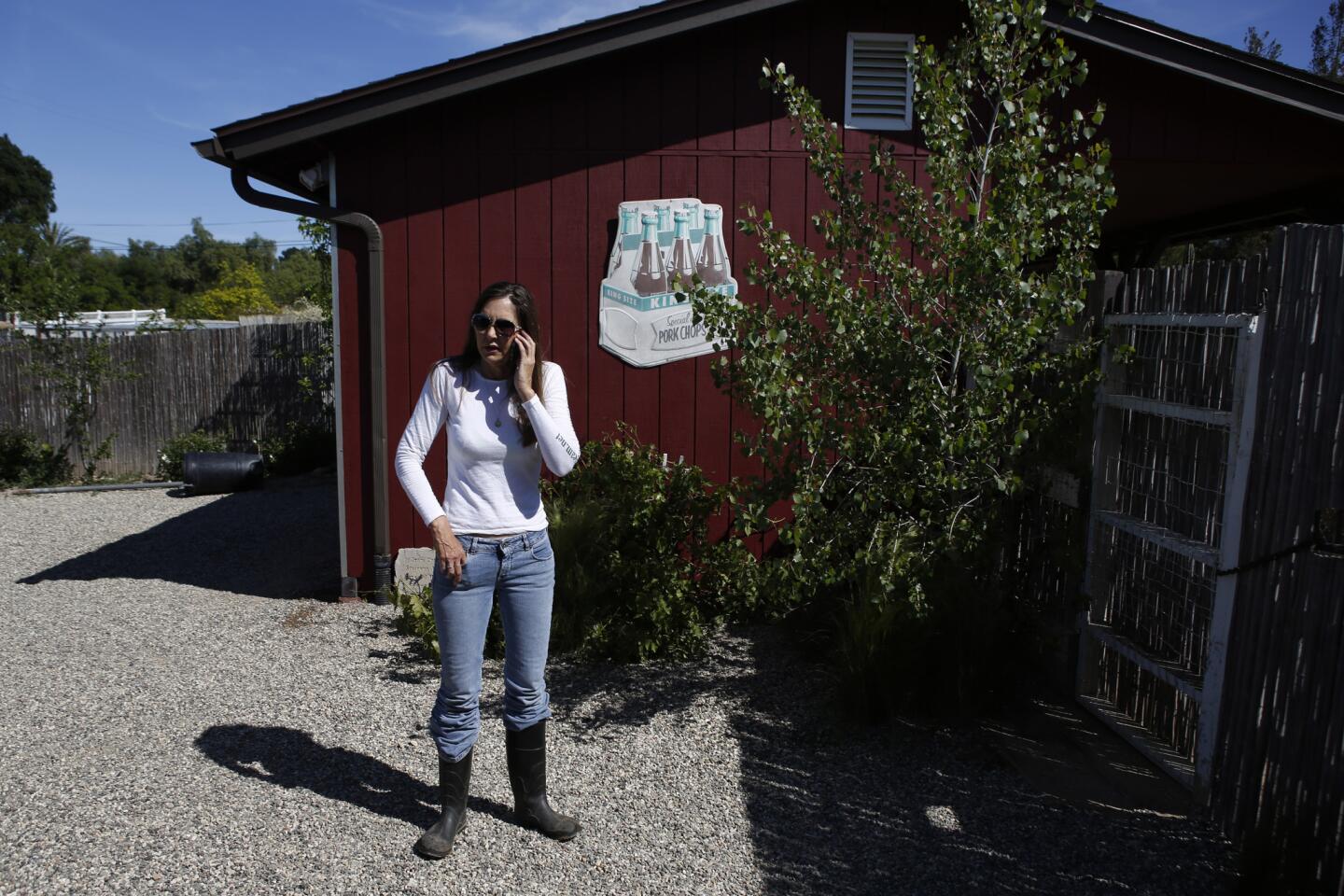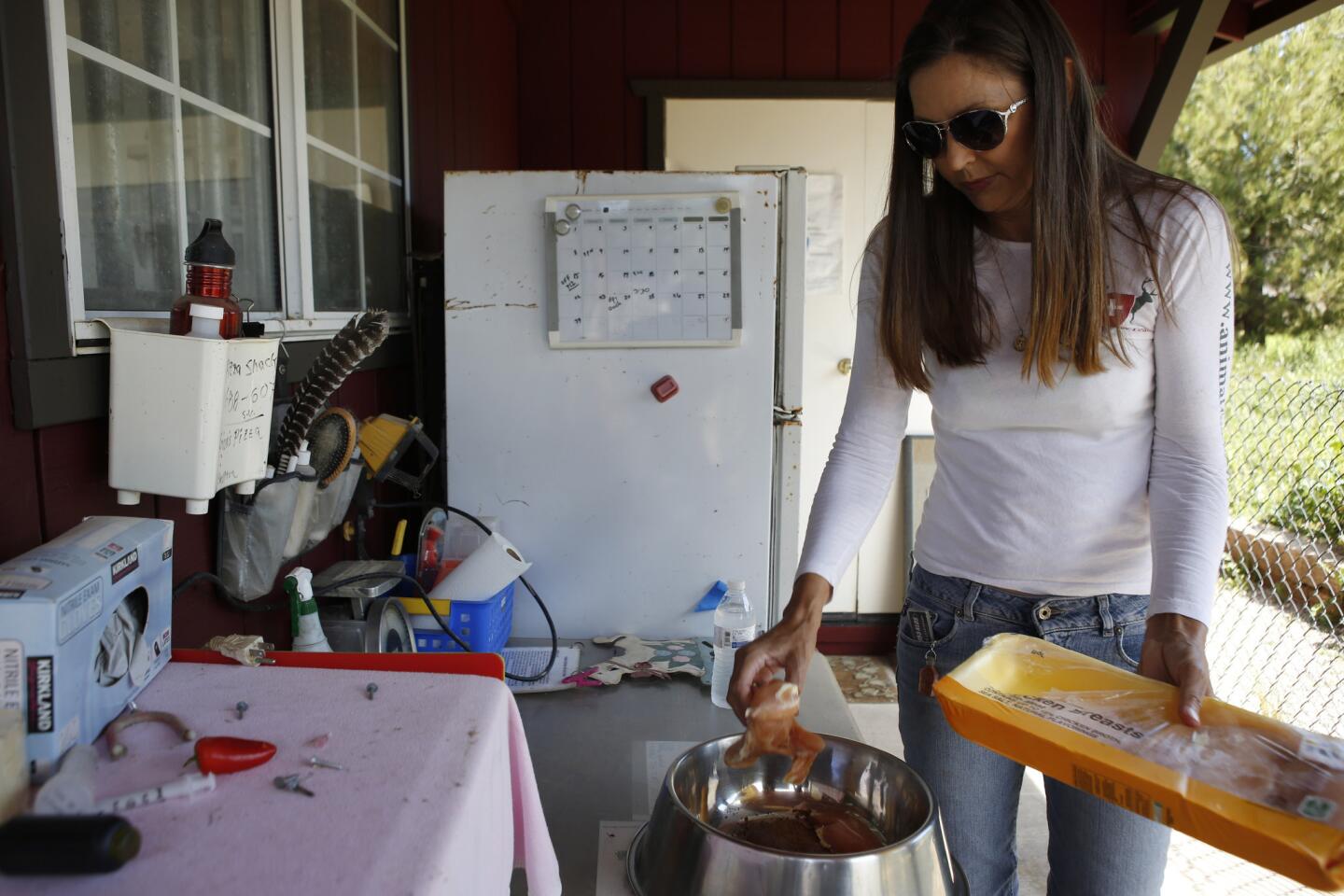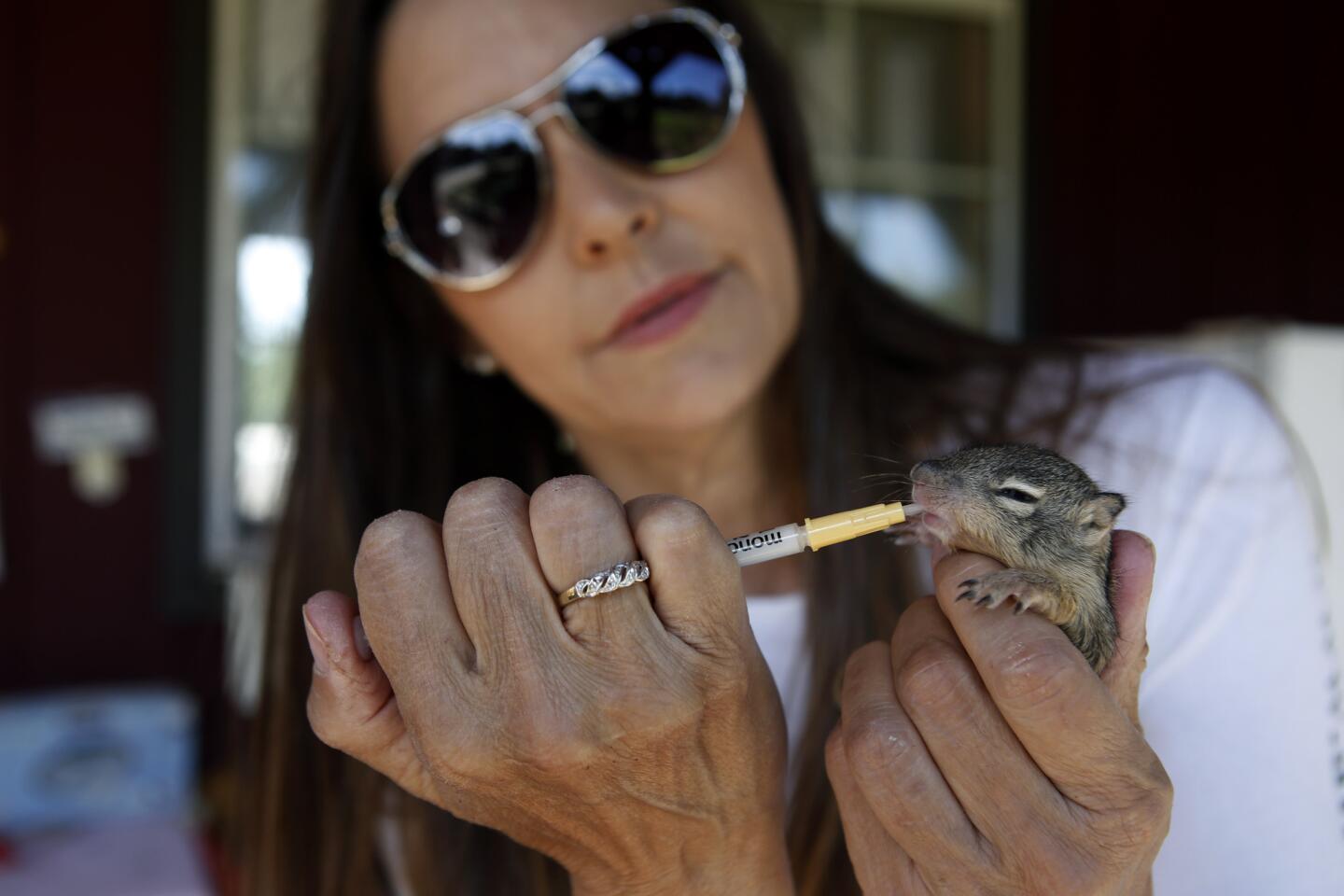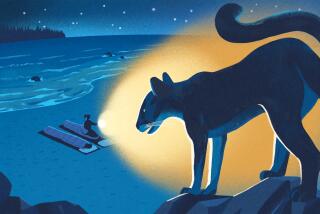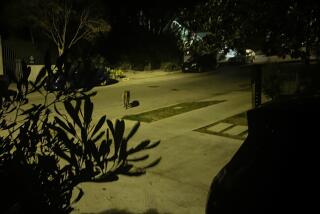Mama coyote, blinded by a bullet, is alive thanks to animal rescuers
- Share via
reporting from SOLVANG, Calif. — The call came in on Julia Di Sieno’s wildlife rescue hotline at 1:35 p.m. Feb. 11: “A coyote has fallen into the empty reservoir over at the Santa Ines Mission.”
Minutes later, Di Sieno was standing at the edge of the stone-and-mortar reservoir, looking 30 feet down on a badly injured and emaciated female coyote huddled in a shadowed crevice.
The animal’s labored breathing, gurgling sounds and bleeding posterior suggested it suffered from upper-respiratory problems, giving the appearance of poisoning.
Wearing Kevlar gloves and armed with a steel pole attached to a catch-noose, Di Sieno hurried down a ladder. It took only a few seconds to realize that the coyote was blind in both eyes.
“As I was pulling her out of the crevice with my catch pole, she went into cardiac arrest,” said Di Sieno, executive director of the Animal Rescue Team in Solvang. “She was dying.”
The 55-year-old licensed rescuer looked up at her assistants and asked them to lower a gurney by rope, along with her medical kit, heavy blankets and towels. Also, she told them, “Stop making noises that could stress this animal more than she already is.”
Di Sieno gave the coyote a shot of epinephrine to kick her heart back into rhythm and began administering chest compressions. The coyote responded by lifting her head a few inches off the ground.
Minutes later, the animal was in Di Sieno’s pickup truck and headed to a veterinary hospital, where the animal’s condition was stabilized with intravenous fluids and vitamins.
X-rays and examinations later found that the coyote, now known as Angel, had been shot between the eyes. The wounded animal apparently wandered for many days, even weeks, in the Santa Ynez Valley until she fell into the reservoir.
Vets also discovered one other thing.

On March 23, while recuperating at Di Sieno’s wildlife rehabilitation facility, Angel gave birth to five puppies.
On a recent day, Di Sieno introduced a visitor to the predator she calls “a courageous girl and most exceptional mother.”
A sign on her wire enclosure read: “Blind coyote! Julia only!” Angel was snoozing in a corner after nursing the little balls of dark gray fur that were yipping and yawning in their sleep.
“What this animal endured is beyond comprehension,” Di Sieno whispered. “When she had puppies, I didn’t know whether to cry in sadness or for joy.”
Di Sieno plans to care for the puppies until they are mature enough to be released in the surrounding mountains. She has big plans, however, for Angel, with whom she has developed strong bonds.
“I want Angel to become a member of the rescue team’s family as an imprintable surrogate mother for young coyotes that come our way.”
“But first,” she acknowledged, “I have to persuade the state Department of Fish and Wildlife not to euthanize her — and that won’t be easy.”
In California, possession of a coyote is illegal unless permitted by the state. Di Sieno also must apply for a special permit to keep a coyote on the premises indefinitely.
Asked about Angel, Fish and Wildlife spokesman Andrew Hughan said, “We are working to find a reasonable solution as quickly as possible.
“The department appreciates Julia and the rescue team’s efforts to save this coyote and other wildlife. We’ve worked closely with her over the years and appreciate her passion for rescuing imperiled wildlife.”
To hear Di Sieno tell it, “I’m hard-wired to do this work.”
Di Sieno was 9 and living in Santa Barbara when she got her first wild animal, a raccoon that was a gift from her father. She gazed upon the blob of striped fur and beheld an extraordinarily inquisitive and intelligent creature from another universe of nature, with its own primitive code of ethics.
A torrent of such creatures flows these days into her nonprofit operation, which runs on a shoestring budget, volunteer work, prayers and Southern rock rhythms issuing from a small radio on a patio table.
Generally, animals orphaned, injured or cruelly abused are kept in spider web-like networks of wire cages and pens maintained by a cadre of volunteers. The creatures include coyotes, bobcats, foxes, deer, squirrels, owls, tortoises, turkeys, geese, lizards, snakes, frogs and an occasional mountain lion.
“In the old days, it was Mother Nature that animals had to deal with,” Di Sieno said. “Now, it’s us — human beings with their guns, poisons, cars and urban sprawl.
“A few weeks ago, we found seven animals — foxes, quail, squirrels and an owl — that had been shot and placed in some kind of ritual circle,” she said.
Angel, too, had been cruelly trapped between the two worlds. “But she trusts me now,” Di Sieno said.
Di Sieno’s supporters include Sheri MacVeigh, a veterinarian at Solvang Veterinary Hospital, who said she believes “that coyote would not still be here had not Julia started cardiopulmonary resuscitation in the field and then brought her to us.”
Then there is conservationist Tom O’Key, whose discovery in 2013 of a bobcat trap on his property near the edge of Joshua Tree National Park triggered a grass-roots fury across the state. Two years later, bobcat trapping was outlawed in California, ending a century-old industry.
O’Key came up with the idea of naming the coyote Angel after learning about her ordeal. “People who dedicate their lives to the interests of suffering creatures like this severely wounded female coyote deserve all the credit and support we can heap on them,” he said.
Di Sieno put it another way. “This coyote put up a good fight, and I fought to keep her alive.
“Never underestimate the will to survive.”
Twitter: @LouisSahagun
ALSO
Last space shuttle tank leaves New Orleans — by sea, not air — for its journey to L.A.
San Fernando Valley residents sound off on proposed bullet train routes
Kobe Bryant to get his name on a Metro station -- for one day only
More to Read
Sign up for Essential California
The most important California stories and recommendations in your inbox every morning.
You may occasionally receive promotional content from the Los Angeles Times.
